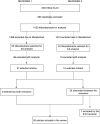Consumption of ultra-processed foods and body fat during childhood and adolescence: a systematic review
- PMID: 28676132
- PMCID: PMC10260745
- DOI: 10.1017/S1368980017001331
Consumption of ultra-processed foods and body fat during childhood and adolescence: a systematic review
Abstract
Objective: To review the available literature on the association between consumption of ultra-processed foods and body fat during childhood and adolescence.
Design: A systematic review was conducted in the PubMed, Web of Science and LILACS databases. Studies that evaluated the association between consumption of ultra-processed food (exposure) and body fat (outcome) during childhood and adolescence were eligible.
Subjects: Healthy children and adolescents.
Results: Twenty-six studies that evaluated groups of ultra-processed foods (such as snacks, fast foods, junk foods and convenience foods) or specific ultra-processed foods (soft drinks/sweetened beverages, sweets, chocolate and ready-to-eat cereals) were selected. Most of the studies (n 15) had a cohort design. Consumption was generally evaluated by means of FFQ or food records; and body composition, by means of double indirect methods (bioelectrical impedance analysis and skinfolds). Most of the studies that evaluated consumption of groups of ultra-processed foods and soft drinks/sweetened beverages found positive associations with body fat.
Conclusions: Our review showed that most studies have found positive associations between consumption of ultra-processed food and body fat during childhood and adolescence. There is a need to use a standardized classification that considers the level of food processing to promote comparability between studies.
Keywords: Adolescence; Body fat; Childhood; Obesity; Ultra-processed foods.
Figures
References
-
- Popkin BM (2006) Technology, transport, globalization and the nutrition transition food policy. Food Policy 31, 554–569.
-
- Popkin BM (2006) Global nutrition dynamics: the world is shifting rapidly toward a diet linked with noncommunicable diseases. Am J Clin Nutr 84, 289–298. - PubMed
-
- Martins APB, Levy RB, Claro RM et al.. (2013) Participação crescente de produtos ultraprocessados na dieta brasileira (1987–2009). Rev Saude Publica 47, 656–665. - PubMed
Publication types
MeSH terms
LinkOut - more resources
Full Text Sources
Other Literature Sources
Medical


